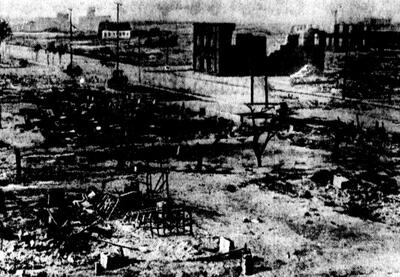May 31 marks the anniversary of the Tulsa Race Massacre. You can be excused if you’ve never heard of it. Despite being the bloodiest attack on African-American citizens in U.S. history, the riot was almost completely ignored by most history books for almost all of the 100 years since it happened. Only recently has the event received the attention it deserves.
In 1921, the Greenwood section of Tulsa, Okla., was one of the most prosperous Black neighborhoods in the country. Greenwood’s nickname was “the Negro Wall Street.” The discovery of oil in Tulsa in 1901 turned the city into a boomtown. In the 1910s, Tulsa's economic good times coincided with an exodus of African Americans from the Deep South called the Great Migration. Oklahoma was a Jim Crow state. But Black people wanted to cash in on the state’s oil wealth like everyone else.
There was one problem: The speedy arrival of so many Black folks—as well as immigrants from overseas—provoked fear among many of Oklahoma's whites. A great number of them had come from the South or the conservative Midwest. The 1910s witnessed a resurrection of the Ku Klux Klan nationally, and Oklahoma joined the trend enthusiastically. Soon after the riot, Tulsa would report more than 2,000 people had signed up with the Klan.
The riot started on May 31, 1921, in the way many racial disturbances did at the time—with an accusation that a Black man assaulted a white woman. Whites gathered to lynch the 19-year-old being accused. But they were surprised when local African Americans, some of them veterans of World War I, moved to defend him with guns. One white man tried to disarm a Black man. They struggled. A shot was fired. The massacre was on.
Black citizens protected their homes and businesses as best they could. But they were badly outnumbered. Within 24 hours, a 42-block area was burned. At least 300 people were killed—most of them Black—but the true death toll could be much higher. About 10,000 people were left homeless, and more than 1,000 homes and businesses were destroyed. Greenwood never really recovered.
The end of Tulsa’s white massacre was the beginning of a massive cover-up. The event was almost completely ignored by most journalists and historians. Official documents, police records and photographs disappeared. People who participated refused to talk about it. Local newspapers from the time vanished. It was as if the worst single incident of racial violence in U.S. history had never taken place.
That began to change about 15 years ago, as African Americans—who had never forgotten—and historians began to demand an accounting. Today, teachers can find many resources. This two-part news story, found here and here, is a good introduction. And this slide show can give students an idea of what Greenwood was like before and after the riot.
The Tulsa Race Massacre is just one chapter of American history that has been deliberately ignored because it involves race. Many students are surprised to find that that familiar landmarks were once sites for lynchings, that racial segregation was once prevalent locally or that the Ku Klux Klan once had a big following in their city. These Learning for Justice articles can show you how to help students uncover their forgotten past.
Price is a former managing editor of Teaching Tolerance.
